In this ongoing series, we ask SF/F authors to describe a specialty in their lives that has nothing (or very little) to do with writing. Join us as we discover what draws authors to their various hobbies, how they fit into their daily lives, and how and they inform the author’s literary identity!
“You like creepy stuff?” a woman whom we referred to as June Moon asked me. “Let me show you something.” June Moon opened a flat file drawer behind the counter and pulled out a promotional picture of a clown dressed in red and white, holding a bunch of balloons. I was 11 at the time and when I saw the photo, I knew what June Moon was showing me. “You know who that is, right?” It was impossible not to know. John Wayne Gacy had just been executed the month before and was all over the news. He’d lived in Chicago, ten minutes from my house. “An original promotional photo, signed,” June Moon said, proud. My mom smiled from across the antique shop, aware but unconcerned.
From infancy I’d been accompanying my mom to antique shops, probably at least one every week or two for the entirety of my childhood. My mom was a true collector and I was tasked with amusing myself while she let her eyes rummage through the glass cases. In the beginning, I contented myself hunting out the hard candy that filled a carnival glass bowl in each booth. I settled in with cheap old paperbacks anthologizing columns from Mad Magazine – Al Jaffee’s Snappy Answers to Stupid Questions or Don Martin Drops Thirteen Stories. I combed through old postcards. On the days when my mom was taking her time, I’d shadow her closely trying to urge her to give up so we could return home, browsing the booths myself in the process.
I remember pointing to a dirty-looking pink teacup with the face of a woman molded into the side one day and saying, “She’s scary.” My mom agreed. The cup reminded me of Mrs. Piggle Wiggle if she hadn’t slept in several nights—a deranged, hypnotizing look in her eyes. I kept that face in my mind, and then I started seeing her in other shops. I felt like she was following me. Finally I asked my mom if we could take a closer look and she summoned the shop owner with her ring of keys. “Schafer and Vater,” the woman told us. “A porcelain maker in Germany until the early 60s.” We thanked her for taking the tiny cup out of the case for us and moved on to the next booth. I kept thinking about Creepy Piggle Wiggle, and when my birthday rolled around, I asked only for the cup. My mom was surprised, but probably also excited that I had shown an interest in something she had exposed me to. She bought me the teacup and I placed it beside my Precious Moments and Beatrix Potter piggy bank on the shelf of treasures in my room.
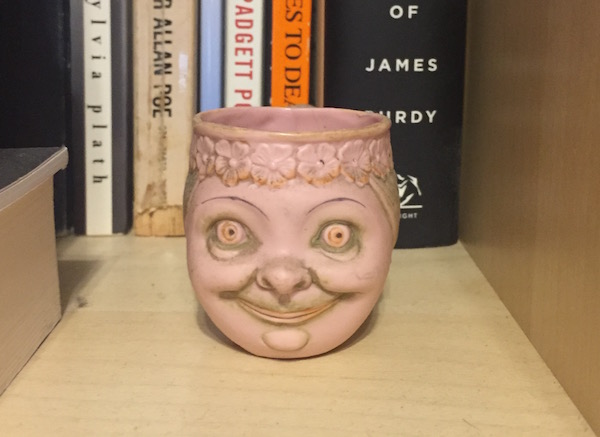
I started recognizing the style of Schafer and Vater: usually a vessel of some sort—bottles, teapots, match strikes and pin cushions; often a green stain gives the figures a peaked glow or a blue glaze collects in the creases giving the figures a shadowy temperament; bugged eyes and mouths stretched wide; a few words of punchline often molded into the base. The shop owners laughed at the little girl who could spot a long defunct German ceramicist a mile away.
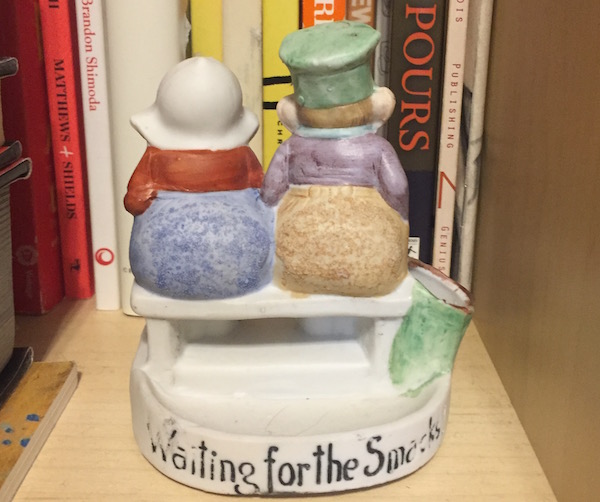
In my grandmother’s china cabinet I pointed to a creamer in the shape of a peasant girl bent under the weight of a basket you could fill with milk. “Is that one?” I asked and we took it out to find the signature “R” stamped on the bottom. We marveled at the coincidence.
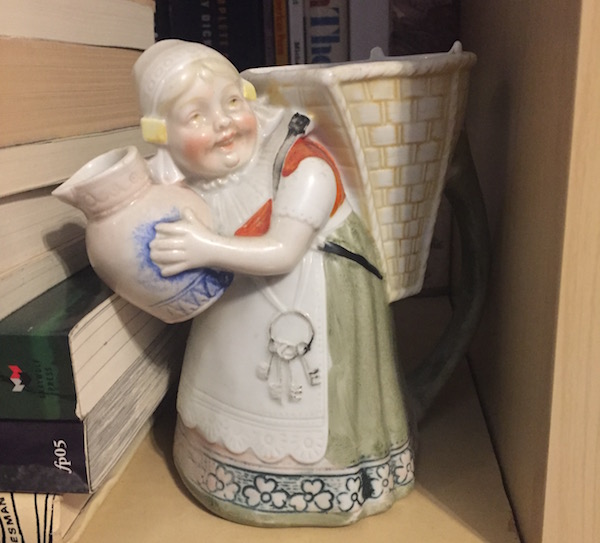
The Schafer & Vater company had been founded in Volsted Rudolstad in 1890 to make luxury items: figurines and doll’s heads and household objects a little too precious to be used for their intended purpose, but the figures showed a humor and horror uncharacteristic of most porcelain trinkets.
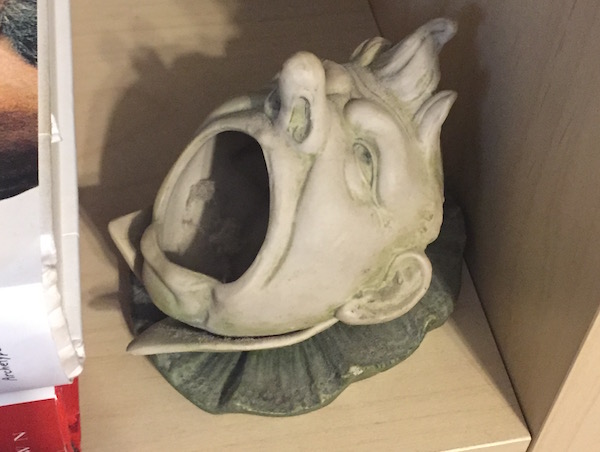
By 1910 these unsettling figures showed up in the pages of the Sears Roebuck catalog alongside doorknobs and women’s wigs. Schafer & Vater became an authorized manufacturer of Rose O’Neill Kewpie dolls—an apt fit, as Kewpie has always seemed a little mischievous, the way her eyes always look away, how she consorts with frogs and refuses to put clothes on.
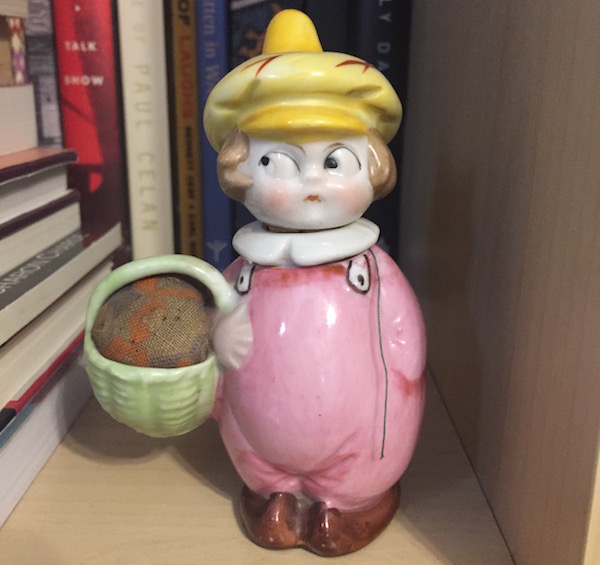
Schafer & Vater would also mass produce “giveaways” for bars and liquor stores, dances and fairs, as promotional gifts to their patrons: mostly flasks and jugs.
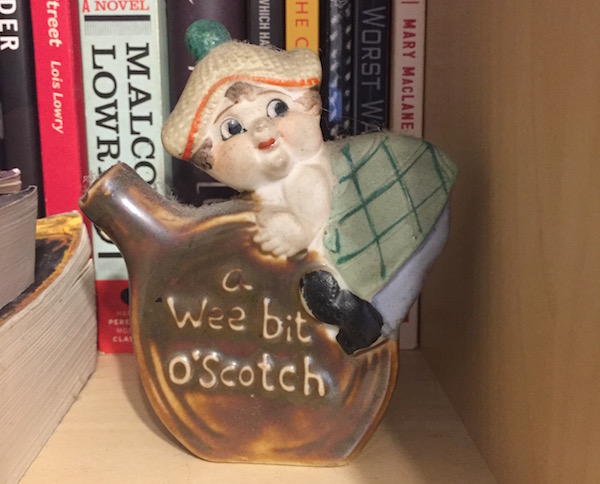
For a long time I only had two or three pieces of the pottery, content with spotting them in shops and admiring them from afar. In the recent past, though, newly acquainted with the wonders of ebay and never having relented in her collector habits, my mom has started hunting out pieces of Schafer & Vater for me and giving me a piece or two for my birthday or Christmas each year. The unsettling figures are beginning to attain a critical mass on the same shelves as my books: a sort of imposed collection placed in front of a willing one, both couched firmly, for the most part, in the realm of the uncanny. My love of the familiar made strange seems has remained consistent over the course of my life thus far
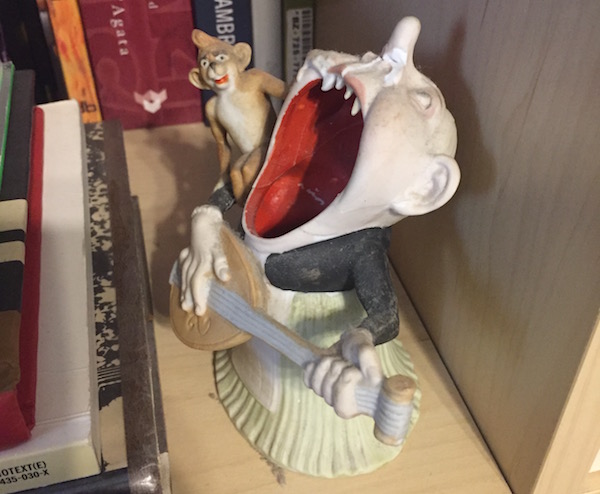
Porcelain figures were expected to be pretty and sweet. The Schafer and Vater figures set themselves apart by being, instead, darkly comic, even a little scary.
My love of fairy tales was quickly replaced by a love of scary stories as a kid: something set in the real world going wrong instead of a distant fairy realm.
I think back to the photo June Moon pulled out to show me, of the joy and humor that’s expected of clowns, and the horror that hid behind John Wayne Gacy’s greasepaint grin, and am reminded of all the threats that can live behind what we believe we know and trust, of what we expect to be one way but are horrified to discover is something entirely else.
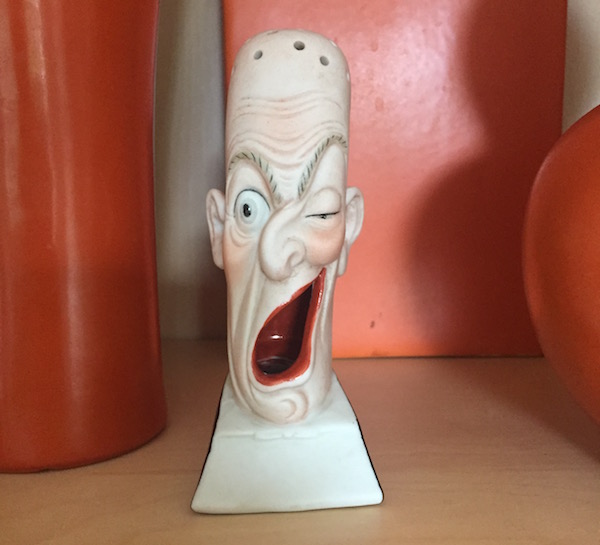
Top image from The Twilight Zone, “The Man in the Bottle” (1960)
 Jac Jemc’s newest novel, The Grip of It, was released by FSG Originals on August 1st. She is also the author of a story collection, A Different Bed Every Time, and the novel My Only Wife, which was a finalist for the 2013 PEN/Robert W. Bingham Prize for Debut Fiction.
Jac Jemc’s newest novel, The Grip of It, was released by FSG Originals on August 1st. She is also the author of a story collection, A Different Bed Every Time, and the novel My Only Wife, which was a finalist for the 2013 PEN/Robert W. Bingham Prize for Debut Fiction.









